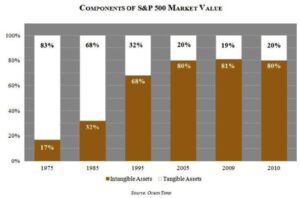We've all heard this before: People are our greatest asset. As an employee, do you believe it? As a manager, do you believe it?
Standard & Poors clearly considers People as one of the 3 top components of a business's value. Experts often refer to key assets as Capital. When it comes to executing on a business strategy, people are your Human Capital. A major asset.
What are the other Intangible Assets, and, why is this important? The S&P 500 chart above shows that business priorities have made a remarkable shift in the past few decades. The value and importance of tangible vs. intangible assets have turned upside down, with intangible assets recognized as the ones most important for organizational success in today’s business environment.
 Tangible assets are bricks and mortar, capital equipment, inventory, and other valuable objects. What are intangible assets? Human Capital is one, along with others such as Intellectual Capital and Leadership Credibility.
Tangible assets are bricks and mortar, capital equipment, inventory, and other valuable objects. What are intangible assets? Human Capital is one, along with others such as Intellectual Capital and Leadership Credibility.
We know in our minds that people should be our greatest asset. Many organizations say they are. Does your organization treat people as its greatest asset? As the saying goes, actions speak louder than words. Organizations who walk the talk, who recognize that people are their greatest asset, take actions to invest in and leverage this asset. There are 3 key ways they do this, bringing value to their people and to the business, both short and long term.
The three highest-impact investments companies can make in Human Capital include:
- Targeted Training
- Knowledge Sharing
- Recruitment and Selection
Targeted Training To build and sustain strategic performance, organizations need to continuously raise the level of employee knowledge and skills that link to the business strategy. Developing employees in strategic areas enables them to contribute to the achievement of strategic objectives and to deliver the company’s value proposition, its unique difference, to the customer.
Often, companies provide training based on industry best practices, past experience, and what's currently popular. However, sustainable strategic performance requires approaches that are tailored to support and enable achievement of a company’s business strategy.
Training and development activities and programs that are aligned with the business strategy help ensure the business will have the capabilities needed in the future. Well-tailored development programs can prevent important skill gaps. Leaders can plan ahead to have key skills available when needed, by leveraging your organization’s learning activities (such as courses, seminars, webinars, mentoring, and special assignments and projects) to provide knowledge and skills needed, both now and in the future, as part of the business strategy.
Knowledge Sharing Current technology makes sharing knowledge much more easily accomplished than in the past, using company social networks and/or shared networks on a company’s intranet. Investing in sharing knowledge can provide significant benefit to employees, by making it possible for them to capitalize on one another’s learnings. Learning from one another and contributing to productivity can occur today as part of the process of doing work.
Employees also tend to find satisfaction in sharing knowledge with others. Respect among peers grows as individuals and groups develop reputations as knowledge providers. Through sharing, knowledge that exists only in the minds of a few becomes more widely held and applied. And, knowledge sharing systems can create a type of “help library” for people in the organization. As knowledge sharing catches on, management can reinforce its continuation and expansion.
Recruitment and Selection An organization’s growth and sustainability also depends on its ability to attract, select, and utilize the right people. Talent acquisition is of high focus lately, with many organizations dealing with skill gaps. Hiring people based on carefully established requirements can continuously re-energize the work environment by adding to the team new self-motivated hires who bring qualities and attributes that fit the desired culture, and who possess capabilities needed both now and in the future to achieve the business strategy.
Impacting Human Capital
Involvement of Human Resources in business strategy and execution is relatively new and is not yet typical in US organizations. Change can be slow in coming, and the drivers of change vary.
The Human Resources function already impacts high-value, intangible assets significantly. For example, hiring, development, retention, compensation, benefits, employee relations, incentives, rewards and recognition…all affect intangible assets.
What are intangible assets?
- Brand
- Intellectual Capital
- Leadership Credibility
- Vendor Relationships
- Human Capital
- Strategic Partnerships
- Execution Capability
In many organizations, H.R.'s impact merely scratches the surface in touching on the total impact H.R. is positioned to have, as shown in the list of intangible assets above. Now, more than ever before, with the heightened value of intangible assets in business, Human Resources professionals have a key opportunity as members of the leadership team, in making the business successful for the short and the long term.
Market Discipline
Aligning a Human Capital plan with the business strategy can address and minimize skill gaps, build retention, promote your brand, strengthen leadership and heighten strategic performance capacity. Strategic alignment requires the company to have Market Discipline. Market Discipline is the ability of leaders to choose their core differentiation or value proposition, the competitive strength that determines their target market and that serves as the strategic cornerstone for alignment of the 5 keys to strategy execution. This article is the 5th of 5 articles in our series on strategy execution.
The 5 Keys to Strategy Execution, combined with Market Discipline, comprise the recipe for successful strategic performance.
What are some ways your organization can improve its investment in and better leverage Human Capital for successful strategy execution? Please share your opinions, experience and thoughts.
